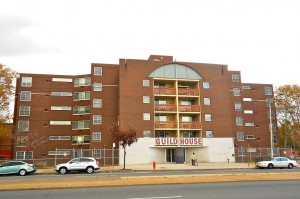Friends Neighborhood Guild
Essay

Friends Neighborhood Guild, a Quaker-founded settlement house and neighborhood center in North Philadelphia, for more than a century has helped residents confront urban issues by offering services, participating in neighborhood redevelopment, and acting as a broker for interactions across ethnic and class lines.
Established in 1879 as Friends Mission No. 1 at Beach Street and Fairmount Avenue, the Guild began as a Quaker outreach effort to immigrants and children working on the waterfront. By 1880, the mission offered a night school for boys, a sewing school for girls, and temperance meetings. The mission’s goals overlapped with the emerging settlement movement, and the institution increasingly focused on helping immigrants to adapt to urban life. In 1899, the mission changed its name to Friends Neighborhood Guild and relocated to 151 Fairmount Avenue.
Throughout the first half of the twentieth century, the Guild provided vocational training, recreation, and health services. Demand for services outgrew facilities at Fairmount Street, and in 1913 the Guild moved to Fourth and Green Streets, where it continued to serve portions of the Northern Liberties, Poplar, and Ludlow neighborhoods.
The Guild sought to help residents of all backgrounds and promote better racial and ethnic relations. While it had earlier served European immigrants, by the 1920s changing residential demographics made African Americans a sizable Guild constituency. By the early 1950s, the Guild also provided an important meeting space and resource for the growing Puerto Rican population and for displaced persons from Eastern Europe. As civil rights struggles developed, the Quaker-controlled institution faced demands for greater local influence, which eventually resulted in community representatives holding half of the seats on the Guild’s governing board.

Under the leadership of Francis Bosworth (1905-83) from 1943 to 1967, the Guild became more involved in neighborhood and community development. The Guild took an advisory role in East Poplar urban renewal efforts and launched Operation Poplar to address juvenile delinquency. Increasingly concerned about the scarcity of affordable housing, in the 1950s the Guild partnered with American Friends Service Committee to develop Friends Housing Cooperative at Eighth Street and Fairmount Avenue, where the Guild relocated its offices once more. The racially integrated cooperative housing development allowed families to buy dwellings with low down payments and sweat equity. In the 1960s, the Guild completed construction of Guild House, an apartment complex for the elderly, at 711 Spring Garden Street. The Guild also facilitated tenant negotiations with public housing officials and assisted rent strikes against private landlords.
By the 1970s and 1980s, the Guild served a neighborhood impacted by deindustrialization and suburban migration. Remaining residents had high rates of poverty and unemployment, and the Guild offered more basic social services. As Philadelphia’s downtown-focused redevelopment continued, the Guild took leadership in opposing a commuter rail tunnel. In the 1990s, the Guild offered energy assistance and began a Freedom School summer program. By 2011, the Guild, which had historically been supported by a mix of Quaker funds, government programs, grants, and United Way allotments, faced financial difficulties as these funding sources diminished. Nevertheless, the Guild continued to serve the area.
Alyssa Ribeiro is a Research Scholar at UCLA’s Center for the Study of Women and teaches at California State University, Northridge. (Author information current at time of publication.)
Copyright 2014, Rutgers University



